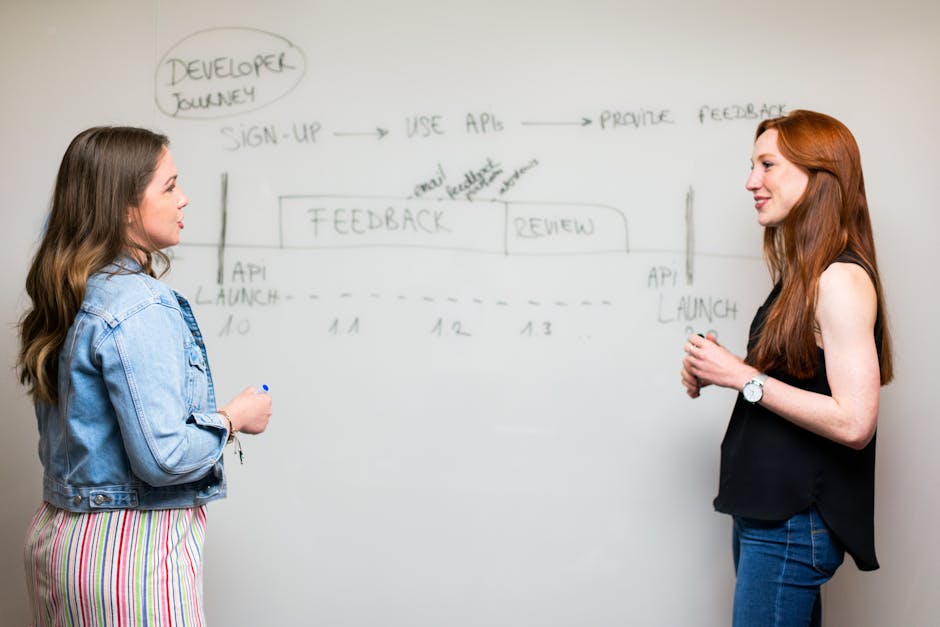Partnering With Developers For Equity: Tips For A Successful Collaboration
So, you’ve got a brilliant idea for a project that could potentially revolutionise the way we live or work, but you might not have all the technical skills needed to bring your vision to life. Partnering with talented developers is an excellent solution for bridging this gap and transforming your concept into reality. Sharing equity in exchange for their expertise can be a mutually beneficial arrangement – both parties stand to gain from the project’s success.
However, navigating through such collaborations requires careful planning and consideration of various factors to ensure that your partnership thrives and delivers outstanding results.
In this article, we’ll explore some essential tips for forging successful partnerships with developers when offering equity as compensation. From identifying potential developer partners who share your passion and values to establishing clear expectations and goals, crafting fair partnership agreements, fostering effective communication channels, and nurturing long-term relationships – every aspect plays a crucial role in bringing out the best in each other while working towards shared aspirations.
Embrace these strategies as you embark on this exciting journey together; after all, innovation thrives when creative minds join forces!
Identifying Potential Developer Partners

As you start searching for potential developer partners, keep these strategies in mind to help you find the right fit. Developer vetting is essential in selecting a partner who can turn your innovative ideas into reality.
To begin with, research their professional background, including work history, portfolio, and client testimonials. Social media platforms like LinkedIn can provide valuable insights into their skill sets and experience level. Additionally, consider attending industry events or joining online forums where developers often network and share knowledge.
Skill assessment plays a crucial role in determining if a potential developer partner alines with your project’s requirements. When evaluating their technical abilities, focus on how well they understand various programing languages, software tools, and development methodologies relevant to your project. Furthermore, assess their problem-solving skills by presenting real-life challenges that might arise during the collaboration process. Communication skills are equally important – ensure that the developer can clearly articulate complex concepts and is open to feedback.
Apart from technical expertise and strong communication skills, finding a developer who shares your vision and enthusiasm for innovation will significantly contribute to the success of your partnership. Engage in deep conversations about your project goals and listen carefully to understand their perspective on how technology can drive growth for your business idea.
Remember that finding the perfect match takes time – don’t rush the process as it may lead to costly mistakes down the line. With patience and persistence in identifying potential developer partners with alined interests and complementary skill sets, you’re one step closer towards establishing clear expectations and goals for a successful collaboration together.
Establishing Clear Expectations and Goals

In the thrilling journey of joining forces, it’s crucial to set clear expectations and goals right from the start, ensuring a smooth path towards triumph.
Expectation alinement is an indispensable component that can make or break your partnership with developers. It’s essential to openly discuss each party’s responsibilities, anticipated outcomes, work ethics, and communication protocols to avoid misunderstandings down the line.
Goal setting strategies are equally important as they help you establish concrete objectives for your project while allowing both parties to contribute their unique skills and expertise. When setting expectations and goals with your developer partner, consider factors like timelines, milestones, quality standards, and potential risks.
Communicate these aspects in a transparent manner so all parties understand what is expected of them throughout the collaboration process. Encourage open dialog by providing opportunities for feedback and brainstorming sessions where innovative ideas can be exchanged freely. This not only helps create a healthy team dynamic but also fosters an environment where creative problem-solving thrives.
As you progress through this exhilarating venture together, establishing trust and maintaining open channels of communication will prove invaluable in reaching your shared goals. Celebrate successes along the way while addressing challenges head-on to ensure continuous growth within your partnership.
With these foundations firmly in place, you’ll be well-prepared to tackle crafting a fair and comprehensive partnership agreement that solidifies your commitment towards mutual success in innovation.
Crafting a Fair and Comprehensive Partnership Agreement

It’s vital to craft a fair and comprehensive partnership agreement, ensuring that both parties are on the same page and ready to tackle challenges together.
Equity negotiation plays a crucial role in establishing a mutually beneficial arrangement. To achieve this balance, consider each party’s contributions, such as time commitment, expertise, financial investments, and overall value addition. Remember that agreement flexibility is key; be open to revisiting terms as the project progresses or if circumstances change.
When draughting the partnership agreement, take the time to thoroughly outline roles and responsibilities for each party involved. This includes decision-making processes, dispute resolution mechanisms, and exit strategy provisions should either partner decide to part ways with the project. By addressing these potential scenarios in advance, you create an environment of trust and transparency while minimising future conflicts.
As you solidify your partnership agreement, keep in mind that fostering effective communication will be paramount for your collaboration’s success. Establishing regular cheque-ins or meetings can help maintain open dialog between all parties involved. In doing so, you’ll create a strong foundation for working together through any obstacles that may arise—setting yourselves up for long-term success as you transition into fostering effective communication and collaboration within your partnership.
Fostering Effective Communication and Collaboration

Navigating the delicate dance of communication and teamwork in your partnership can truly make or break the success of your joint venture, so let’s dive into some strategies to keep things harmonious and productive. The key ingredients for fostering effective communication and collaboration are active listening, building trust, and maintaining a culture of openness.
To paint a picture for you, here are some practical ways to achieve these goals:
-
Active listening:
-
Practise fully focussing on what your partner is saying without interrupting.
-
Ask clarifying questions to ensure understanding.
-
Paraphrase their points to demonstrate comprehension.
-
Building trust:
-
Be transparent about expectations, concerns, and progress.
-
Consistently deliver on promises and meet deadlines.
-
Foster an environment where vulnerability is embraced.
-
Maintaining a culture of openness:
-
Encourage open dialog around challenges and potential solutions.
-
Provide constructive feedback with empathy and respect.
-
Celebrate successes together as well as learn from failures.
By implementing these strategies, you’ll create an atmosphere where each party feels heard, valued, and confident in their contributions. Remember that it takes time to build strong relationships; be patient with yourself and your partner as you navigate this journey together.
As you continue down this path of effective communication and collaboration, not only will the quality of your work improve but also the satisfaction derived from working together.
As your partnership matures through effective communication practises, it’s essential to nurture this long-term relationship for continued success. In our next section about nurturing long-term relationships with developers for equity partnerships, we’ll explore more techniques that help solidify connexions built on trust while fostering innovation throughout the life of the project.
Nurturing Long-Term Relationship for Continued Success

Cultivating a thriving, lasting bond with your developer team is like tending to a lush garden, where trust and innovation bloom harmoniously for continued prosperity.
To nurture this long-term relationship for sustained success, it’s essential to implement effective growth strategies that evolve with the ever-changing technological landscape. Prioritising open communication channels and fostering an environment of mutual respect will inevitably lead to a robust partnership that thrives on creativity and shared goals.
A continuous improvement focus is vital in maintaining the momentum of your collaborative journey with developers. This can be achieved by setting measurable objectives, regularly reviewing progress, and adapting processes as necessary to ensure optimal performance.
Encourage your development team to stay up-to-date with emerging technologies and industry trends, allowing them to refine their skills while simultaneously bolstering the overall strength of the partnership. By investing time in professional development and providing opportunities for growth within the team, you’ll create an atmosphere where innovation flourishes–benefitting both parties involved.
The key to nurturing a long-lasting relationship with developers lies in being willing to adapt together through inevitable challenges faced along the way. Maintaining transparency during tough times demonstrates commitment towards building trust between partners while also emphasising the value placed on collaboration.
Recognise individual contributions within your development team, celebrating wins collectively as they arise; these small tokens of appreciation contribute significantly towards sustaining motivation levels high throughout each project phase.
As you continue cultivating this vibrant partnership garden filled with trust, ingenuity, and shared triumphs–your combined efforts will surely yield bountiful fruits of success for years to come.
Frequently Asked Questions
How do I determine the fair percentage of equity to offer a developer in exchange for their services?
Imagine you’re sailing the high seas of equity negotiation, navigating through uncharted waters to ensure your developer stays motivated and engaged.
To determine the fair percentage of equity to offer a developer in exchange for their services, begin by evaluating the value they bring to your venture. Consider factors like their experience, skill set, and level of commitment.
Additionally, compare similar partnerships within your industry to establish a benchmark. Keep in mind that offering too little may cause resentment and demotivation while offering too much might dilute your ownership stake.
The key is finding that sweet spot where both parties feel valued and motivated to work together towards innovation and success – it’s all about striking that perfect balance as you steer your ship towards unexplored territories of growth and prosperity.
What are the tax implications of partnering with a developer for equity, and how can I best prepare for them?
When navigating the tax implications of partnering with a developer for equity, it’s essential to have a solid tax planning and equity structuring strategy in place. By properly allocating shares and understanding the potential tax consequences, you can maximise your financial gains while minimising your liability.
Consider consulting with a tax expert or attorney who specialises in start-up ventures and equity arrangements to help you create the most advantageous structure for both parties involved. This proactive approach not only demonstrates your commitment to innovation but also ensures that you’re well-prepared for any future tax-related surprises as your collaboration evolves and flourishes.
How can I protect my intellectual property and ideas when partnering with a developer for equity?
Did you know that intellectual property (IP) theft costs US businesses more than $225 billion annually?
Safeguarding your ideas and IP rights is crucial in any collaboration, especially when partnering with a developer for equity. To ensure your hard work isn’t compromised, consider implementing non-disclosure agreements, registering patents or trademarks, and outlining clear terms of ownership within contracts.
By taking these proactive measures, you’ll not only secure your valuable assets but also foster an innovative environment where creativity flourishes without fear of exploitation.
Don’t let potential threats hold you back; protect what’s rightfully yours and keep pushing the boundaries of innovation!
What are some common challenges or pitfalls that may arise during the collaboration, and how can they be best mitigated?
When embarking on a collaborative project, you’ll likely encounter challenges such as developer communication and risk management. To overcome these hurdles, foster an environment of open dialog and active listening to ensure that everyone’s ideas are heard and considered.
Establish clear expectations regarding responsibilities, timelines, and deliverables from the outset to minimise misunderstandings. Implement robust risk management strategies by identifying potential risks early on, evaluating their impact on the project, and developing contingency plans to mitigate them effectively.
By being proactive in addressing these common pitfalls with creative solutions and innovative thinking, you can pave the way for successful collaboration and bring your visionary ideas to life.
How can I effectively assess a developer’s skills, experience, and fit for my project before entering into an equity partnership?
Navigating the maze of developer assessment can feel like trying to find a needle in a haystack, but it’s essential for ensuring you’ve found the perfect fit for your project.
Skill validation is crucial, so start by reviewing their portfolio and past work to analyse their coding abilities and style. Don’t shy away from conducting technical interviews or tests; this helps illuminate their problem-solving skills and ability to innovate under pressure.
Additionally, explore their communication style and cultural fit with your team, as collaboration is key for successful equity partnerships.
By employing these techniques, you’ll confidently secure a skilled developer who shares your vision for groundbreaking innovation and success.
Conclusion
So, you’ve made it this far – and that’s no coincidence. Your dedication to building a successful partnership with developers for equity has brought you closer to turning your vision into reality.
Keep in mind the importance of clear expectations, fair agreements, open communication, and nurturing long-term relationships. Your journey may be filled with challenges and uncertainties, but remember: success often blossoms from such coincidences.
Stay focussed on fostering collaboration and watch your business thrive!
Contact us to discuss our services now!
